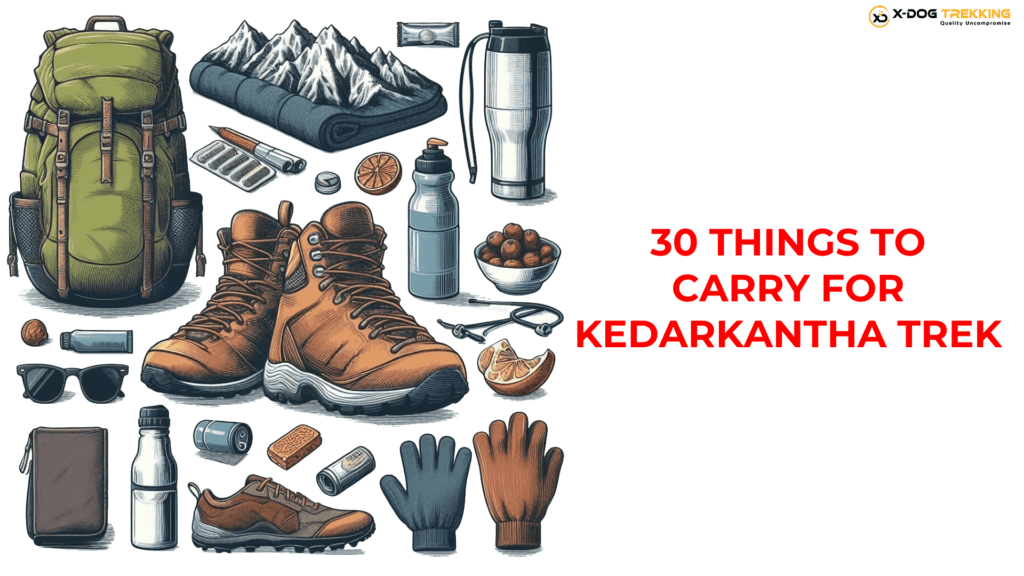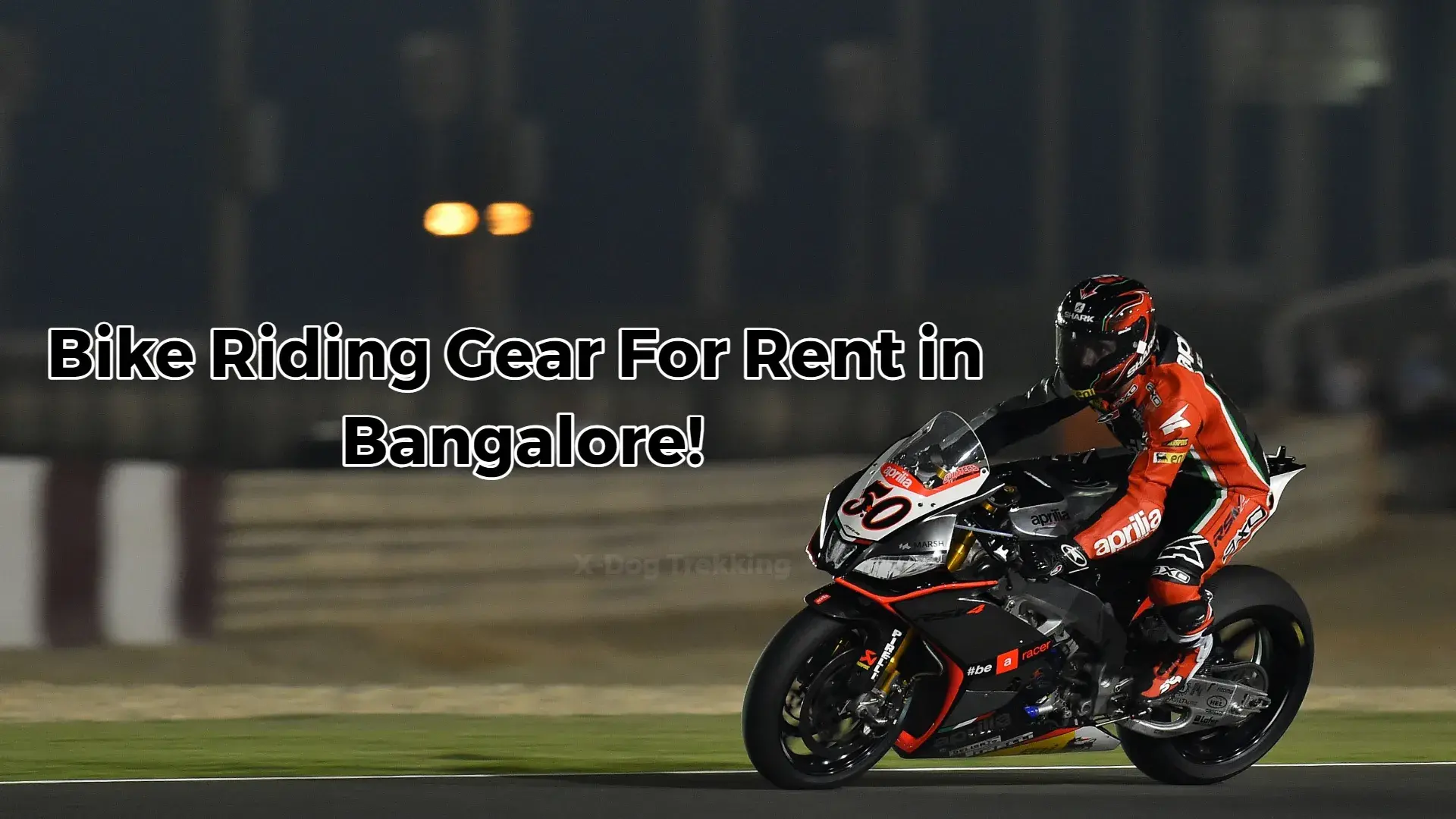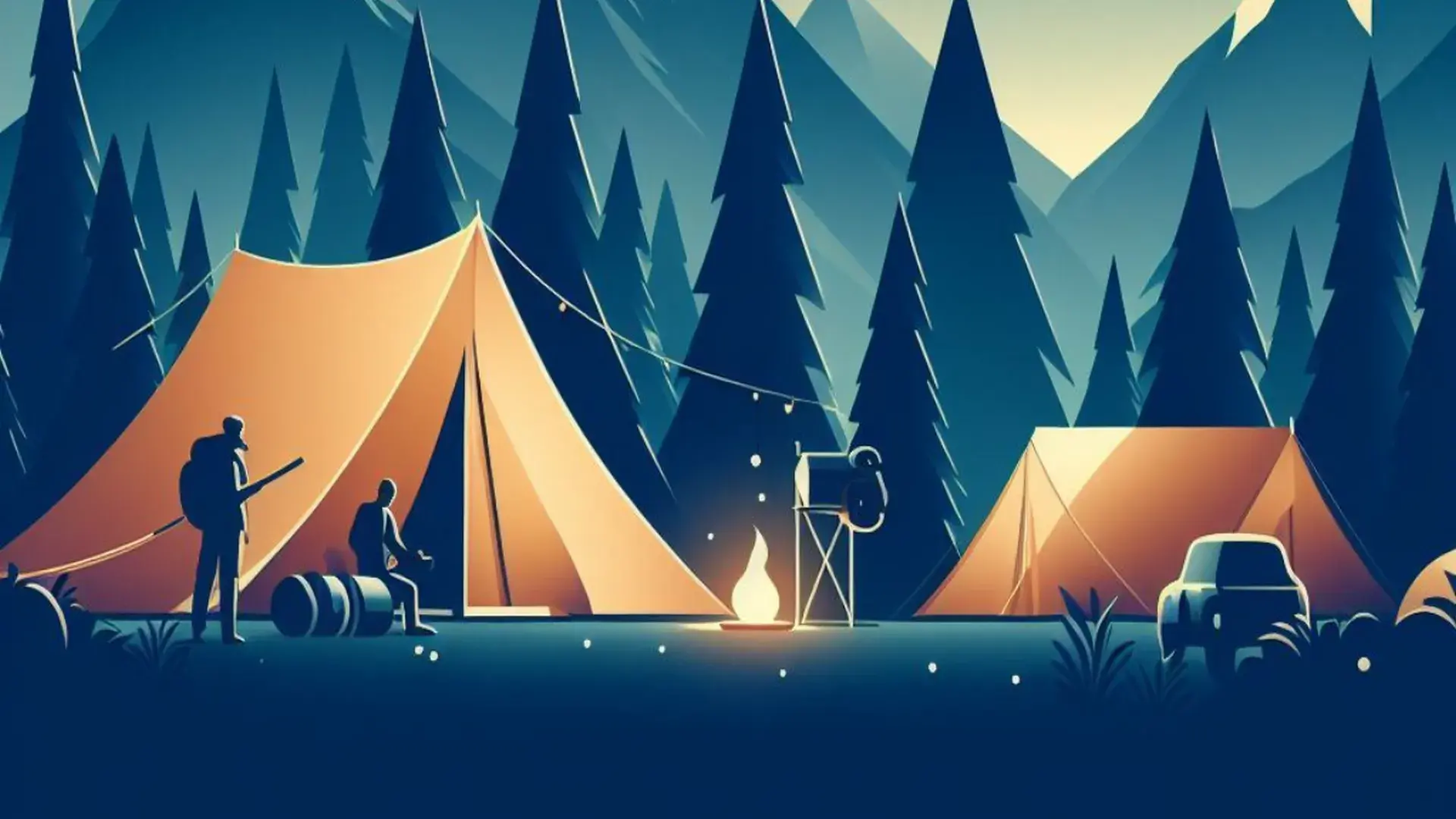This blog post covers a specific list of things to carry for Kedarkantha trek. It details 30 essential items from trekking gear, equipment, camping essentials, and more along with tips and advice for each. Additional information on renting select gear is also provided.
Nestled in the Garhwal Himalayas, the Kedarkantha trek is one of the most popular winter treks in India. The views of the snow-capped peaks and alpine forests along the way make it a trekker’s paradise. The trek starts from the quaint hamlet of Sankri, Uttarakhand at 6,400 ft and culminates at the Kedarkantha peak at 12,500 ft.
The views of majestic Himalayan peaks like Swargarohini, Bandarpoonch, and Kalanag from the top are breathtaking. However, trekking in the cold climate of winter requires proper preparation, planning, and packing. Having the right clothing, gear, footwear, accessories and other essentials is key to having a safe and comfortable trekking experience.
So whether you are an experienced mountaineer or a newbie going on your first Himalayan trek, use this guide to make sure you pack wisely and prepare thoroughly before embarking on the thrilling winter trek to Kedarkantha Peak! To fully enjoy this moderately difficult trek, proper planning and packing are crucial.
Things To Carry For Kedarkantha Trek: A Complete Guide
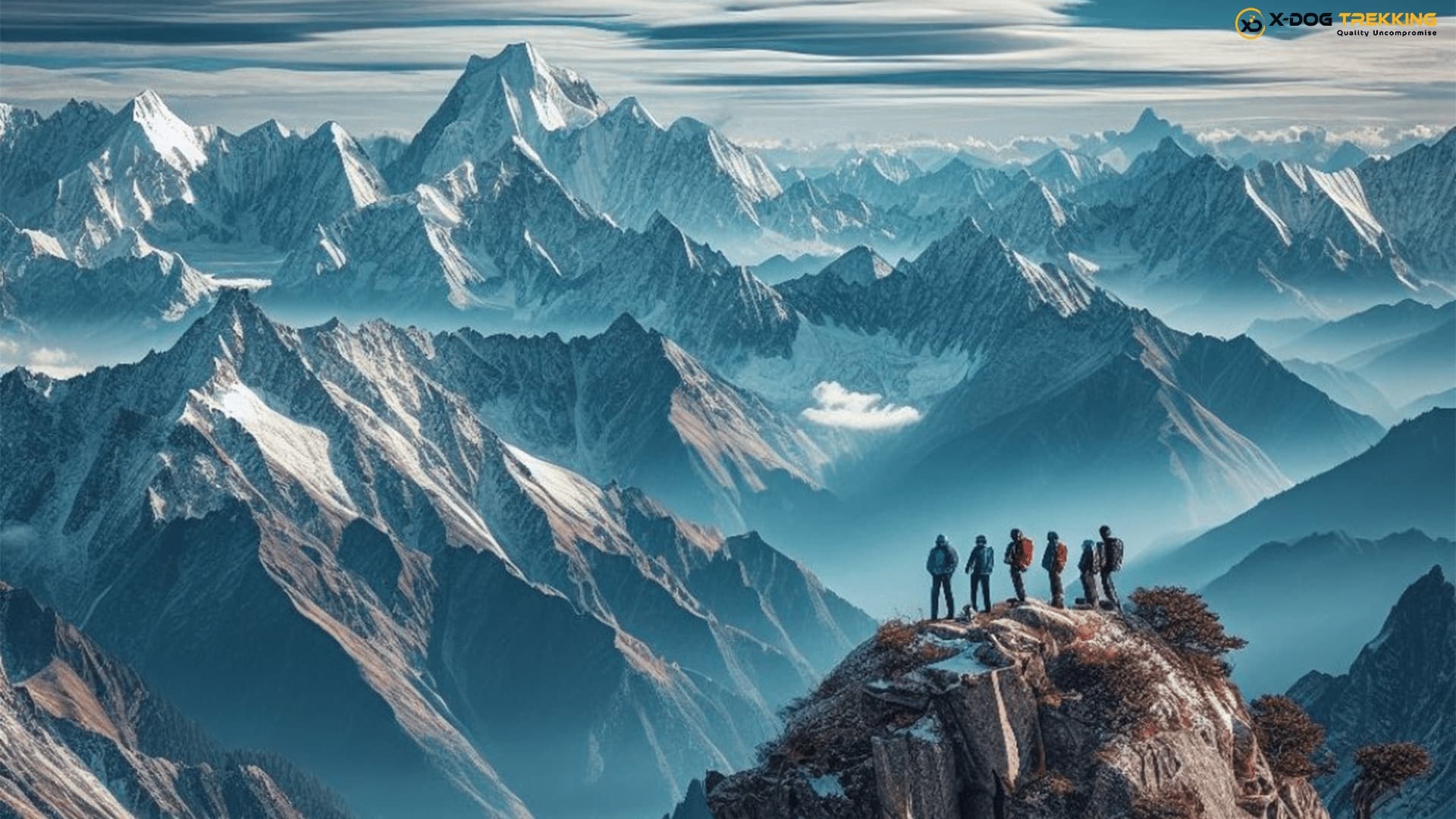
1. Valid ID Proof
Carrying an original and valid photo identity proof is mandatory for any trek in India. This is needed at checkposts and campsites. Recommended ID proofs are an Aadhar Card, Driving License, Voter ID, or Passport. Avoid carrying originals and keep 2-3 photocopies instead. If you are a foreign national, carry your passport and valid Indian visa. Keep your ID proof safe and secured during the trek.
2. Good Quality Backpack
Your backpack is the most essential piece of trekking gear. Go for a branded backpack with a capacity of 60-70 liters. It should have a good hip belt to transfer weight to the hips, adjustable straps, a ventilated back panel, and an expandable collar.
The material should be durable like nylon or polyester with a waterproof rain cover. Waterproof the bag with ponchos or plastic wraps as porters sometimes stack bags carelessly. Go on short hikes wearing the loaded pack to test comfort. Alternatively, rent good backpacks from trek gear rental companies.
➛ Best Trekking Backpack On Rent
3. Trekking Shoes
Ideal trekking shoes are waterproof, have good grip, provide ankle support, and have a sturdy build. The outsole should be from reputed brands like Vibram with deep lugs for traction on slippery terrain.
High ankle collars add support and prevent debris from getting inside. Break in new shoes by wearing them around before the trek. If you don’t want to buy expensive shoes, renting is a good option. Make sure the shoes are still in good condition, fits well, and are comfortable.
➛ Trekking Shoes For Rent (Waterproof)
4. Trekking Poles
Trekking poles are very useful in the mountains as they improve stability, reduce strain on the knees, and help propel you forward. Adjustable aluminum trekking poles are lightweight and offer versatility for uphill and downhill sections. They distribute the load by up to 25% from the knees to the shoulders and arms.
Look for comfort grips, adjustable wrist straps, anti-shock features, and interchangeable tips. Learn the correct techniques to maximize efficiency. Renting poles is suggested for infrequent trekkers. Make sure the poles are not damaged, are of proper height, and have good grips.
➛ Mountain Trekking Pole For Rent (Anti-shock)
5. Headlamp
A headlamp frees up your hands at camp for cooking, changing clothes, etc. in the dark. Look for one with different lighting modes, brightness settings that go beyond 100 lumens, and a red light mode that preserves night vision.
It should have an adjustable band to fit perfectly on your head. Always carry spare batteries since cold can drain them faster. A headlamp also comes in handy if you get caught in the dark during summit attempts. Consider renting a headlamp if you won’t use it much otherwise.
➛ Best Rechargeable Head Torch For Rent
6. Sunglasses
Sunglasses are mandatory for eye protection in the snowy environment at high altitudes. Go for wrap-around polarized glasses from reputed outdoor brands that cut glare from sun, snow, and water. UV-protected lenses with a 100% UV 400 rating offer complete protection.
If you wear prescription glasses, you can get custom sunglass inserts for your frames. Make sure the sunglasses fit over your prescription glasses comfortably without slipping. Carry a neck cord to prevent loss and a hard case for protection. Avoid cheap low-quality sunglasses that can harm your eyes.
7. First Aid Kit
A first aid kit can be a lifesaver in the mountains. Stock it with essential medications, bandages, antiseptic creams, pain relief sprays & gels, cotton, gauze, medical tape, blister care supplies, scissors, hand sanitizer, disposable gloves etc. Also, include any personal medications.
Make sure all the medications are unexpired. The kit should be portable, waterproof, and readily accessible. Know how to use each component. You can customize readymade kits available from outdoor retailers. Renting a first aid kit makes sense if you are new to trekking. Just replenish any item you use during the trek.
8. Raincoat and Pants
A good quality waterproof and breathable rain jacket and pant is vital for protection from rain, wind, and snow. It should have taped or sealed seams to prevent leakage along with hoods, storm flaps, and adjustable hems. 2-3 layer jackets with ventilation options are ideal.
Get ones that pack small and are lightweight. Choose bright colors for visibility. Make sure they are roomy enough to layer clothes underneath. Cheap plastic ponchos are not ideal. You can rent good rain gear from outdoor gear rental companies before the trek. Check for defects in zippers, tears, etc before renting.
➛ Best Waterproof Rain Coat For Rent
9. Backpack Rain Cover
If your backpack does not come with an inbuilt rain cover, get a removable one. It should be made from a waterproof material and fit snugly over the pack without sagging. Make sure you get the right size rain cover for your backpack.
Attach it properly over all the extremities of the pack. Seam-sealed designs prevent leakage. Having this extra layer of waterproofing gives added protection for your belongings inside. You can easily rent a rain cover along with your backpack from any gear rental company.
➛ Backpack Cover for Rain for Rent
10. Day Pack
You need a hardy but compact 15-20 liter day pack to carry your essentials during summit attempts, day hikes, and as a summit bag. It should have side pouches for quick access to water bottles, front stash pockets to quickly access snacks or layers, and chest/waist straps for stability.
Look for an air mesh back panel for ventilation and minimal weight. Keep it light by packing only necessities like water, snacks, spare layer, first aid, phone, etc. inside. Hydration-compatible day packs allow the use of hydration bladders or water bottles. These are easily available for rent if you don’t want to buy one.
11. Trekking Gaiters
Gaiters are worn over trekking shoes to prevent debris like pebbles, gravel, snow, and dust from getting inside. They also keep the pants from getting caught in the lugs. Look for durable, water-resistant ones with secure closures.
Make sure they are high enough to fit over your shoes and socks without sagging. The bottom should be reinforced and have a sturdy front clip. Try wearing your gaiters before renting to assess sizing and comfort. Examine for any damage or wear and tear if renting used gaiters.
12. Camping Slippers
Camping slippers are a nice luxury that makes hanging time at camp comfortable. They should be lightweight, pack down small, quick-drying, and have a rugged sole with tread for grip.
Closed-toe designs prevent stubbing the toes on rocks. Make sure they are not too tight or loose when trying out before renting. Wear with fresh socks to relax your feet after long trekking days. They can be easily rinsed and dried overnight for reuse.
13. Sun Cap
A wide-brimmed sun cap protects your face, ears, neck, and head from harsh UV rays at high altitudes. Choose one with UPF rating and chin straps or drawcord to prevent it from being blown away by the wind. Mesh side panels allow ventilation and sweat evaporation.
Go for a cap made from quick-dry, breathable fabric. Make sure it fits you well without being too tight or loose when renting. Adjust the chin strap for a snug fit. Wear a cap over a woolen beanie for layered protection. Renting caps is ideal if you won’t use them much afterward.
➛ Best Trekking Hat On Rent (Summer Cap)
14. Balaclava
A balaclava protects the head, neck, and face from cold winds, sunburn, and frostbite. Merino wool balaclavas are excellent as wool insulates even when wet. Choose one that fits snugly and covers all exposed areas fully.
It should have some stretch to pull down easily over the head when required. Make sure there are no gaps around the nose or eyes when trying one for renting. Carry a spare balaclava in case the one in use gets wet. You can also opt for a multifunctional buff instead of a balaclava.
➛ Best Merino Wool Balaclava On Rent
15. Thermal Innerwear
Woolen or synthetic thermal inners trap body heat and wick away sweat to keep you warm and dry. They are meant to be worn next to the skin under other layers. Avoid cotton which soaks up sweat.
For the top, choose long sleeves and a close-neck design. The bottom should be full-length ankle-length leggings. Try on the thermals with your other layers before renting to assess sizing and layering comfort. Look for any defects in stitching or pilling in the fabric.
16. Quick-Dry T-shirts
Quick dry synthetic t-shirts prevent sweat accumulation, odor, and chill. Branded trekking t-shirts also come with a UPF rating for sun protection. Choose light-colored full sleeves and a breathable, lightweight fabric that fits snugly.
Carry at least 2-3 t-shirts to cycle through during the length of the trek. Make sure there are no visible stains, tears, or loosening of shapes when renting used ones. Wash and sun dry overnight to sterilize before wearing.
17. Fleece Jacket
A fleece jacket traps air and provides excellent insulation and warmth for its weight. Although not waterproof, fleece dries quickly when wet. Choose a thick 200-300 gram weight fleece from Polartec or Thermolite.
It is worn over base layers and under a down or rain jacket. An unzippable jacket allows for ventilation adjustment. Ensure proper arm and body length when renting. Check for damaged zippers, collar elastics, and any pilling in the fabric.
18. Puffy Down Jacket
Warm, compressible, and lightweight, down jackets are unbeatable for insulating capacity. The feathers trap heat while allowing moisture to escape. 900+ fill power down provides maximum warmth with minimal weight.
Get duck or goose down with water-resistant DWR coating. Make sure it fits comfortably over other layers. When renting, examine for missing feathers through the outer fabric. Do a blow test for leakage and assess the loft and compressibility.
➛ Best Columbia Jacket For Winter On Rent (-16 Degree Ultra Light)
19. Waterproof Trekking Gloves
Waterproof insulated gloves provide hand protection and dexterity for activities like setting up tents, cooking, etc. They have a better grip compared to mittens. Look for breathable waterproof membranes like Gore-Tex and PrimaLoft insulation.
Ensure proper fit without constricting circulation when trying before renting. The outer shell should be abrasion-resistant. Examine the gloves inside-out for any leakage, torn insulation, or separating seams if used. Known brands are more reliable for quality.
20. Trekking Pants
Preferred over jeans, trekking pants are light, quick-drying, and abrasion-resistant. They are made from soft shell fabric or convertible designs with zip-off lower legs. Useful features are UPF rating, vent zips, durable fabric, and gusseted crotch.
They provide ease of movement over varied terrain. Try sitting, squatting & stretching when renting to assess comfort and fit. Look for any tears, holes or loose stitching in used ones. Wash and sun dry pants overnight to get rid of bad odors before use.
21. Trekking Socks
Proper trekking socks can prevent painful blisters and keep feet comfortable. Look for wool or synthetic padding around toes, heels, and ankles prone to blisters. Quick-drying, moisture-wicking liner socks worn under help too.
The socks should not be too tight or loose when worn with the trek shoes. When renting, check for holes, sagging elastic, and worn fabric along the toes and heels. Socks are best rented new rather than used ones.
22. Hydration System
A 2-3 liter capacity hydration bladder system allows you to drink water frequently without taking off your pack. The long sip tube makes reaching the nozzle easy. It carries more water than bottles.
Look for wide mouth openings for easy cleaning and anti-microbial properties to prevent mold. Make sure the bite valve, tubing, and seals are intact when renting used ones. Scrub thoroughly with chlorine tablets before use.
23. Reusable Cutlery
Carry your own reusable spoon, fork, and insulated mug. This avoids generating trash from disposable plates and cutlery on the trek.
Opt for durable, lightweight options. Metal spoons tend to develop a weird smell over time. Rent cutlery along with your camping gear or from trek gear rental companies. Make sure they are not chipped or bent.
24. Sunscreen Lotion
Generous use of SPF 30+ broad spectrum UVA/UVB sunscreen is vital in the high UV environment of the mountains. Reapply every few hours even if not directly sunny. Zinc-based creams stay on better than lotions.
Check if you have any allergies when trying a new sunscreen. When renting, check manufacturing dates and use before the product expires. Don’t rent previously opened or used tubes. Discard any sunscreen past its shelf life.
25. Lip Balm
Intense sun and cold dry winds make lip balm essential to prevent chapped and cracked lips. Beeswax-based balms stay on better than oils or petroleum jelly. SPF protection is an added bonus.
When renting, opt for sealed new lip balm sachets. Don’t use ones that have been opened or used previously. Remember to apply the balm generously and reapply every few hours during the trek.
26. Biodegradable Toiletries
Carry travel-sized toiletries for bathing and sanitation needs like small soaps, sanitizer, sunscreen, toothpaste tablets, etc. Opt for biodegradable eco-friendly options that won’t pollute water bodies when the used waste is discharged.
Items like soaps, shampoos, and wet wipes come in handy mini packs that are just right for a short trek. When renting toiletries, ensure the products are sealed, unused, and not past expiration dates.
27. Trekking Sandals
Sturdy trekking sandals with dampening midsoles and good grip make easy camp shoes. Their quick-drying open design is perfect for stream crossings or relaxing at camp. Ankle straps add stability over rocky terrain.
Test sandals with the trek socks you will be wearing when renting to check sizing. Make sure the straps, buckles, and lugs are not worn out or damaged. Proper fit should allow some wiggle room for feet to swell on long days.
28. Camera / GoPro
Capture the stunning Himalayan landscapes with your digital camera, GoPro, or phone camera. Carry spare batteries or power banks to manage battery life. Get a dry bag or waterproof case to protect the camera from rain and falls.
When renting, check everything is in working order – batteries, memory card, lenses, etc. Examine for any physical damage like cracks or dents. Know how to operate the camera before the trek begins.
29. Portable Charger
Recharge your phone, camera, GPS device, etc. anywhere with a power bank. Get one with a capacity of at least 10,000 mAh and multiple charging ports. Ensure the power bank is fully charged before renting. Check that it is functional by attaching a device and charging for a few minutes.
30. Camping Stove
A camping stove is an essential item for cooking food and boiling water during treks. Small portable stoves powered by gas cylinders offer a reliable flame even in windy conditions compared to open fires. Choose lightweight canister or liquid fuel stoves from brands like MSR, Primus, or Coleman based on fuel availability. Make sure all tubes, valves, and gaskets are intact if renting a used stove. Understand the safe usage and priming before use. Reputed outdoor gear rental companies like XDog Trekking in Bangalore offer well-maintained camping stoves for rent.
➛ Coleman Portable Butane Camping Stove On Rent
What should I carry with me for the Kedarkantha trek?
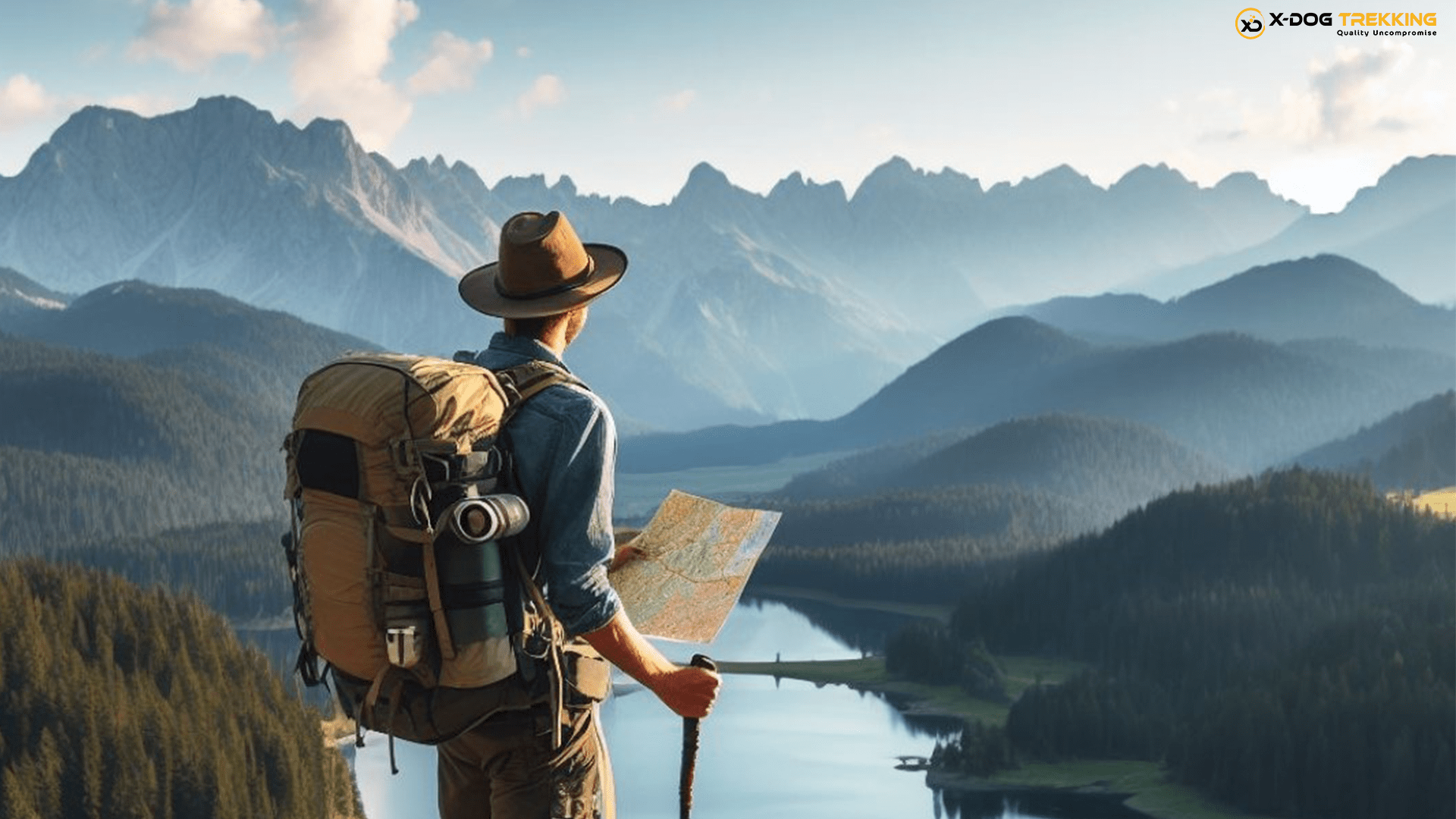
➢ Necessary Camping Gear
- Sleeping Bag: A warm and comfortable sleeping bag is essential for a good night’s sleep, especially at high altitudes where temperatures can drop significantly at night. Choose a sleeping bag with a temperature rating that matches the expected conditions.
- Sleeping Mat: A comfortable sleeping mat provides insulation and cushioning between you and the cold, hard ground. It can significantly improve your sleep quality and comfort during the trek. Consider a self-inflating sleeping mat for added convenience.
- Tent: A lightweight and weather-resistant camping tent is crucial for safe and comfortable camping throughout the trek. Choose a tent with adequate space for you and your belongings, and ensure it has a waterproof rating to withstand potential rain or snow.
➢ Trekking Essentials
Carrying valid photo ID proof is mandatory for any trek in the Himalayas. Keep your Aadhar card, driving license, voter ID, or passport along with a few photocopies. Invest in a good quality backpack with a capacity of 60-70 liters and a rain cover. Waterproof trekking shoes providing ankle support and sturdy soles give grip on slippery trails. Adjustable trekking poles improve stability and reduce knee strain on steep sections. Don’t forget a headlamp, UV-protected sunglasses, and a well-stocked first aid kit.
➢ Staying Dry
Waterproof and breathable outer layers like raincoats and pants protect from getting wet in unpredictable mountain weather. Use a rain cover for the backpack if it is not water-resistant. Trekking gaiters worn over shoes prevent snow and debris from getting inside.
➢ Clothing Essentials
Woolen gloves, balaclava, and thermal inners worn next to the skin prevent sweat accumulation and keep you warm in the cold. Quick dry t-shirts and trek pants are preferred over jeans for ease of movement. Fleece and down jackets provide insulation in freezing temperatures. Get woolen trekking socks to avoid blisters.
➢ Other Accessories
A sturdy daypack to carry summit gear, a hydration system to drink water on the move, a reusable cutlery set to avoid plastic trash, and biodegradable toiletries are must-haves. Trekking sandals give respite from closed shoes at camp. Don’t forget sun protection like wide-brimmed caps, sunglasses, and high SPF sunscreens.
➢ Electronics
Power banks let you recharge mobile devices on the go. Good cameras capture stunning views better than phones. Make sure you carry spare batteries as cold drains them faster.
➢ Cooking Gear
Portable camping stoves like MSR Whisperlite are essential for cooking meals and boiling water. Renting one is a good option for occasional trekkers. Reputable outdoor gear rental companies like XDog Trekking in Bangalore offer well-maintained equipment.
➢ Additional Tips
Try to pack light and minimize luggage weight. Waterproof your gear using dry bags or plastic wraps. Don’t forget vital medicines, energy food items, and mandatory documents. Proper preparation and packing ensure a safe and comfortable trek.
FAQs about Kedarkantha Trek
The Kedarkantha Trek is a captivating Himalayan expedition that takes you to the summit of Kedarkantha Peak, offering panoramic vistas of snow-capped peaks, lush meadows, and verdant forests. This 4-5 day trek, spanning approximately 25 kilometers, commences from Sankri village and culminates at the peak, where you’ll be rewarded with breathtaking views of the surrounding mountains.
The Kedarkantha Trek unfolds its beauty during the winter months, from November to April, when the weather is favorable, with clear skies and pleasant temperatures. The snow-capped peaks and the crisp mountain air create an enchanting spectacle. However, if you prefer a milder climate and blooming meadows, the summer months, from May to June, offer an alternative trekking season.
The Kedarkantha Trek falls under the moderately challenging category, making it suitable for both beginners and experienced trekkers. The well-defined trail with gradual ascents provides a manageable challenge, while the high altitude demands physical fitness and acclimatization.
To embark on this trek, you’ll need to obtain a Forest Permit from the Forest Check Post at Mori, located approximately 70 kilometers from Dehradun. The permit costs ₹50 per person per day.
A well-equipped backpack, sturdy trekking shoes, warm clothing, rain gear, a sleeping bag, a headlamp, and a first aid kit are essential items for your Kedarkantha Trek. Trekking poles and a water bottle are also highly recommended.
Conclusion
Planning and packing properly for a trek is essential to maximize safety and enjoyment. This comprehensive packing list covers all the essential clothing, gear, accessories, and items you need to carry for the Kedarkantha trek. Additional items can be rented from outdoor gear rental companies to reduce load. Following the layering system and packing light are key tips. Let me know if you have any other trekking questions!


